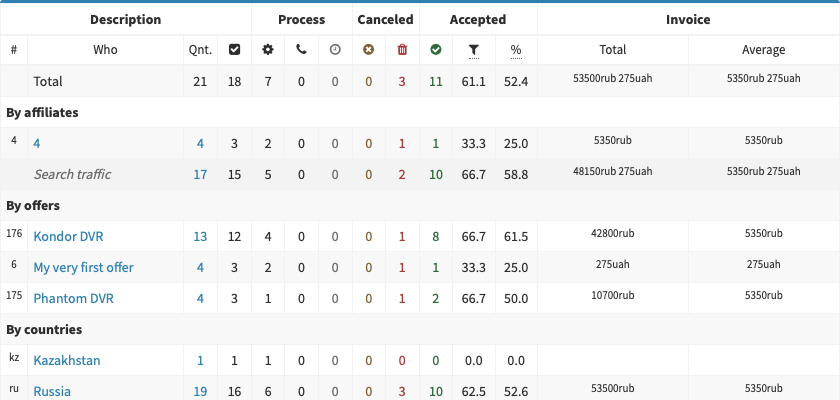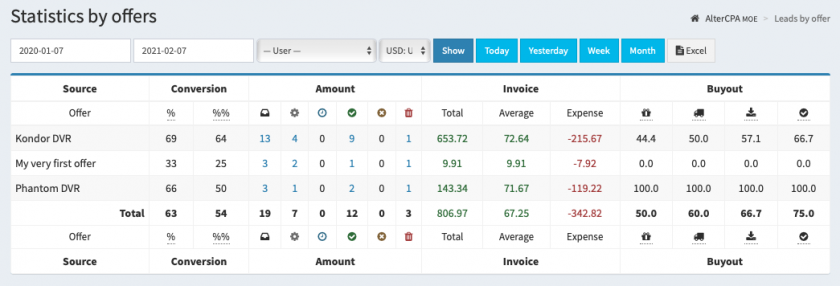Statistics and analytics
AlterCPA Moe includes not only CRM itself, but also a couple of useful tools for statistics and analytics of your orders.
Order statistics
In the "Traffic" section in the personal account of the company administrators and in the "Statistics" section of the personal account of the affiliate (traffic source), there are several reports that can be used to evaluate your traffic in terms of useful parameters.

- Leads by source: statistics by the traffic sources you added, where "Search traffic" corresponds to traffic without a source — your own leads (company administrator only).
- Leads by date and hour: shows statistics in the context of the lead time.
- Leads by offer: analyzes statistics by offer.
- Leads by country: statistics by countries indicated by the lead.
- UTM tags: statistics in the context of standard UTM tags.
- External tags: statistics in the context of your order ID and source tags (affiliate only).
Each of these reports contains the following fields:
- Conversion rates: the percentage of confirmed leads with and without trash leads. It is calculated as the ratio of leads in hold and approval to the total number of received or valid leads, respectively.
- Number of leads, received for the selected period: valid leads, processing, hold, approved, cancelled and trash (not included in the number of valid leads).
- Invoice amount statistics: total and average invoice amount for approved orders. The currency in which the amount is displayed is selected in the form above the report.
- Orders buy-out statistics, which is better to tell in more detail.
We calculate four buy-out indicators. You can focus on the most useful in your particular case:
- The percentage of completed orders among all confirmed leads. It takes into account even those orders that have not yet been sent to recipients.
- The percentage of completed orders among parcels in transit. All sent orders are counted.
- The percentage of completed orders among delivered parcels. The parcels that are in the "Delivered", "Completed" and "Returned" statuses are taken into account.
- The percentage of completed orders among finished orders. Only completed and returned packages are counted.
The former is ideal for assessing the long term, while the latter is appropriate for analyzing the short term and recent shipments.
Order and lead analytics
In the personal accounts of the company administrators there is a report "Analytics of orders", and in the personal account of the affiliate there is a very similar to it "Analytics of leads".

The analytical report is shown in the context of several parameters: affiliates, offers and countries. When you click on the name, the report will be filtered by the selected offer, affiliate or country. When filtering by affiliate, a breakdown by its sources appears in the statistics. When filtering by country, statistics by region are shown.
To see the name of a column, just hover the mouse over its icon.
The report shows the number of leads depending on their status:
- Total number of all leads received during the selected period.
- Number of valid leads — these are all leads, except for canceled ones for trash reasons.
- Orders in progress — statuses "New" and "Processing".
- Orders in the call center — "Call back" status.
- Orders in "Hold" status.
- Orders in "Cancel" status without reason or with valid cancellation reason.
- Orders in "Deleted" status or "Cancel" with trash reason.
Approval indicators are calculated as the number of confirmed leads in relation to the number of valid or all received leads. Leads in hold are not considered approved in this report.
The company administrators also have access to statistics on the invoice amount for confirmed orders: total and average amount for all available currencies.
Call analytics
Call analytics is very similar to order analytics, it has the same field composition and statistics breakdown. The most important difference is that it works not with the date of of the order received, but with the date of its change.

Regardless of when the order was received, it will appear in this report exactly at the moment of its change. In the "Processing" block, not the number of orders is counted, but the number of changes — calls from the call center and hold.
Delivery analytics
The cornerstone of any product traffic is delivery analytics. This tool should be the first page that your staff analyst opens at the start of the day.

Just like the analytics of orders or calls, the delivery report provides data broken down by affiliates with sources, offers and countries with regions. In addition, there is a division by delivery services.
Quantity counters of orders show how many orders are in a particular status: total approved, on packaging, sending, in transit, delivered, paid and returned. The status name will appear if you hover over its icon.
Buy-out rates work similarly to statistics reports: all orders accepted, shipped, delivered and completed.
The gross and average invoice amounts are calculated for paid orders and displayed separately for each currency.
In the finance block, you can calculate your net profit. The expense displays the cost of orders sent. In the income, the amount of purchased leads is shown. Profit is calculated from these two indicators. The currency can be selected in the form above the report.
Call center statistics
Call center statistics allows you to analyze the work of your operators and teams. It is especially useful for working with the main call center. This report shows a summary table of calls and a detailed history of all changes that this table is based on.

Column values in the statistics table:
- Quantity — the total number of orders that have passed through all stages.
- Call center: orders — the number of orders that went through the main call center.
- Call center: taken — the number of orders that the operator took from the "New" status.
- Call center: call — the number of calls in which the operator set the time of the next call.
- Call center: hold — number of operations on orders in the hold status.
- Call center: cancel — number of orders rejected for a valid reason.
- Call center: trash — number of deleted orders or trash cancellations.
- Call center: accepted — number of approved orders.
- Call center: approve — percentage of approved orders among all processed orders, including canceled as trash.
- Call center: quality — an indicator of the quality of the operator's work, which is calculated as the ratio of approved orders to the sum of approved and canceled orders.
- Call center: upsale and cross sale — the number of items of the main and additional goods added to the order.
- Store: packing — the number of orders that have been packed in the warehouse.
- Store: sending — the number of orders that have been sent and are in delivery.
- Delivery: orders — number of orders processed by the monitoring department.
- Delivery: arrived — number of calls for delivered orders.
- Delivery: accepted and returns — the number of orders that were marked as completed or returned.
- Money: invoice — average invoice amount for approved orders.
- Money: salary, bonus, total — indicators of automatic calculation of salaries.
In this table, the most useful metrics are agent performance and average invoice amount. These are the indicators that you can punish and reward your operators for.
Delivery statistics by operators
Delivery statistics allows you to analyze the success of operators and teams working in the "primary" call center. The compisition and meaning of the report columns matches the delivery analytics report.

At the moment of order confirmation, CRM remembers which operator confirmed it. This report collects data on confirmed orders by team and operator. Please note: the date for this report is the moment the order is received in CRM, not the moment it is confirmed.
